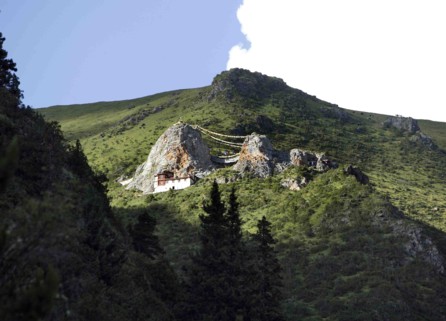Pema Shelpuk 聖地:蓮花水晶窟
Pema Shelpuk (Wyl. padma shel phug), the 'Lotus Crystal Cave' — a famous pilgrimage site located at about four hours' trekking distance above Dzongsar Monastery. It is counted as one of the twenty-five most important sacred places in all of East Tibet, representing the enlightened speech aspect of enlightened qualities. It is said to have been blessed by the four masters Garab Dorje, Shri Singha, Guru Rinpoche and Vairotsana. It was there that Chokgyur Dechen Lingpa discovered the Three Classes of the Great Perfection (Dzogchen Dé Sum) terma cycle, and Jamyang Khyentse Wangpo placed a statue of Guru Dewachenpo in the cave. Jamyang Khyentse Chökyi Lodrö would often stay there in the summer.
蓮花水晶窟(水晶蓮洞)位於宗薩寺上方大約四小時路程的聖地,屬於東藏二十五大聖地之一,代表著證悟功德的證悟語。此地據說曾受四位大師所加持,包括極喜金剛、吉祥獅子、蓮師,以及毘盧渣那[譯師]。秋吉.德千.林巴在此取出「大圓滿三部」(Dzogchen Dé Sum)伏藏法,此處也是蔣揚.欽哲.汪波(Jamyang Khyentse Wangpo)置放一尊大樂蓮師塑像之處。蔣揚.欽哲.確吉.羅卓經常於夏天在此處閉關。
譯註:照片可見於 http://blog.xuite.net/yeshi_tsogyal/twblog/142808848
Orgyen Tobgyal Rinpoche writes:
- Surrounded by white mountain cliffs, the valley of Meshö is like an open lotus flower and the foothills covered with meadows and forests. Flowers grow abundantly in summertime and water flows here and there. In the middle, the heart of the lotus, is a huge white rock with a cave in the center called Padma Shelpuk, the Lotus Crystal Cave. The rock, cave and surrounding area are all white in color. The cave contains many naturally appearing images and letters. Yeshe Tsogyal practiced in a small cave to the left, which has windows which also appeared naturally, though they look man-made. The practice caves of Vairotsana and Shri Singha with their naturally-appeared thrones are at the top of the rock. The Padma Shelpuk, which people called the Ghost Cave, was a cave no one dared visit. Whoever went there was eaten right away. People sometimes saw a one-eyed woman they said was the ghost. A bald-headed man riding on a goat was also seen.[1]
Notes
- ↑ Orgyen Tobgyal Rinpoche, The Life of Chokgyur Lingpa, Rangjung Yeshe Publications, 2000, page 8.
